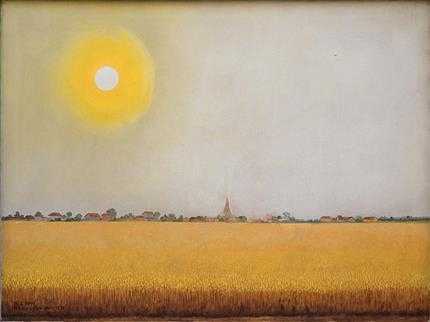About Mahmoud Javadipour
Mahmoud Javadipour is one of the pioneers of modern Iranian art in painting, printing, and graphic design. Between 1941 and 1947, he was trained in the art school affiliated with Tehran University (Modern Fine Arts School) under the supervision of professors such as Mohammad Ali Heydarian and Marte Celestine Yves, a French painter. In 1949, Javadipour, Hossein Kazemi, and Ahmad Esfandiari's works were exhibited at the Cultural Association of Iran and France. One of his most important steps was the establishment of the first Iranian gallery, the famous Apadana Gallery, together with his friends Hossein Kazemi and Houshang Ajudani in 1949. This gallery had a decisive role in the fate of modern Iranian art. The first solo exhibition of this artist was also held in the same Apadana. Javadipour went to Germany in 1951 and studied at the Academy of Fine Arts in Munich for two years with the help of the German government. After returning to the country, he started teaching art at the Faculty of Fine Arts in Tehran and went to Munich again to continue his studies. In 1955, the Supreme Council of Culture of the country evaluated his qualifications' scientific value as equivalent to a doctorate. During his time at Tehran University, Javadipour also held managerial responsibilities, such as the director of the visual arts department. He also taught art at the Academy of Fine Arts, Kamal Al-Molk Academy, and the Academy of Decorative Arts.
Since he started working at the printing house of the National Bank of Iran, Javadipour has devoted most of his work to illustration and graphic design. In the illustration of textbooks and children's books, the creation of securities and signs often used the pictorial tradition and Iranian motifs. He also experimented with printing and created his first colored linocut prints when he was staying in Munich. Later, in 1960, he exhibited a collection of his graphic works, engravings, and pottery in Reza Abbasi Hall.
As a painter, Javadipour has worked on subjects such as the single face, landscape, life scenes, and stories in different ways and styles. It seems that this diversity comes from the doubt and duality of his innovation and conservatism, but he said: "For me, everything, from animate and inanimate to what passes through my mind, comes to my ears, is placed in front of my eyes, or in stories. And legends can inspire my paintings. In this way, I have a wide field to choose the subjects of my paintings. And to better describe the subject I have chosen, I will choose the work tool, the paint, and the technique I should use."
Javadipour's paintings were exhibited many times in Iran and other countries. Tehran Museum of Contemporary Art published a picture book about his artistic life in the "Pioneers of Iran's Modern Art" series in 2001 while introducing a relatively complete collection of his paintings.
The Most Expensive Artwork
At Auctions
First Attendance
28 May 2013
# Attendance
10
# Artworks
10
Average Realized Price
13,364 USD
Average Min Estimate
10,048 USD
Average Max Estimate
13,997 USD
Sell-through Rate
100%
Average Growth of Artwork Worth
10.228%
Timeline
Modern and Contemporary Collector exhibition
7 February
FINE FOLK OUTSIDER auction
18 November
The 19th Tehran -Classic and Modern Iranian Art auction
24 January
Modern Collectore exhibition
19 January
MIDDLE EAST MODERN & CONTEMPORARY auction
5 July
From Object to Figure exhibition
24 September
Painting, group exhibition exhibition
24 April
No.6 auction
16 October
یازدهمین دوره حراج تهران auction
5 July
Foad Sharifi Print Makings exhibition
12 April
In Praise of the Day exhibition
12 April
The 9th Tehran- Classic and Modern Iranian Art auction
29 June
هفتمین دوره حراج تهران auction
7 July
پنجمین دوره حراج تهران auction
27 May
چهارمین دوره حراج تهران auction
29 May
دومین دوره حراج تهران auction
28 May
